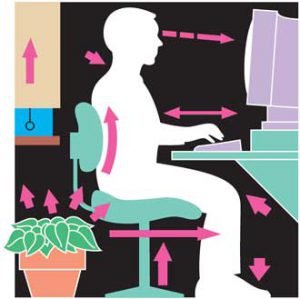 Ergonomics a growing field, work-related disorders a growing concern
Ergonomics a growing field, work-related disorders a growing concern
By Jim Hynes
There was a time not so long ago when the “lift with your legs” signs – you know the ones, where the box-toting stickman worker has what appears to be bolts of electricity shooting out of his lower back – were about the only kind of work-related health advice you were ever offered. But times have changed, and so has the way we work.
Not that many of us lift heavy boxes as part of our jobs any more. These days, we are a lot more likely to suffer a workplace injury or develop a disorder from sitting in front of a computer all day long. And many of us make matters worse by doing it all over again back at home, clicking away at the Internet.
Poor posture resulting from the improper positioning of computer keyboards, monitors, mice, and chairs is one of the causes of the most common work-related injuries. Some of these complaints are further compounded by the repetitive and prolonged use of certain muscles, which can lead to repetitive-stress disorders like Carpal Tunnel Syndrome and epicondylitis (otherwise known as tennis elbow).
Offering relief are the office equipment companies, with their space-age chairs and computer accessories. But don’t be fooled by all that high-tech gear with the word ‘ergonomic’ in front of it. As ergonomist Cynthia Carsley says, the secret to avoiding work-related malaises is not in the equipment itself, but in how you use it.
“I think the big misconception is that a certain piece of equipment – and every week there is a new piece coming out – is going to solve your problem,” says Carsley, a consultant on ergonomics issues to the McGill Sports Medicine Clinic. “It’s not about the equipment. I see people with lovely chairs that are ‘ergonomic,’ but they are not much use if you are not adjusting them properly. What usually leads to problems is a lack of information or education.”
That education and information is exactly what Carsley provides in her job at health promotion centre Axio Health Group. A physiotherapist by training, she started her career in private orthopaedic clinics, and soon grew concerned at the number of work-related injuries and disorders amongst their clientele.
“I was seeing a lot of CSST patients, people who had injured themselves by spending too much time in front of a computer, and getting repetitive strain injuries or work-related musculoskeletal injuries. I thought, wouldn’t it be interesting to prevent those or help people get back into work who were off work.”
So back to school she went, earning a Master’s in Occupational Health at McGill, and taking some post-graduate courses in ergonomics at UQAM.
Today, Carsley does everything from giving seminars on good workplace ergonomics to consulting her customers in their office equipment purchases, and, most important of all, setting up them up properly.
“I basically got myself educated to know the workplace and workplace health,” she says.
At McGill, the science of ergonomics is the domain of Dr. Julie Côté and her colleagues at the Occupational Biomechanics and Ergonomics Lab, a Department of Kinesiology and Physical Education satellite research site located at the Jewish Rehabilitation Hospital in Laval. As the lab’s Director, Côté supervises a number of grad students conducting biomechanics research using state-of the art motion-analysis and other high-tech systems that gauge body movements.
The rise of work-related physical disorders, Côté says, has as much to do with a change in our lifestyles as it does to how we work.
“Today, we think that it’s better not to move. We can make more money by staying at our computers, and going everywhere by car. But we were built to move. We still do, but somewhere along the way we changed the way we do it. Because of computers, we started making very repetitive movements of very small amplitude. We have to move quickly, click quickly, move the wrist quickly, but they are all such small movements that we have to have constant muscle tension to keep the posture. And that’s a problem.”
Education and prevention, she says, are one way to get people to break the habits that end up causing them such great pain.
“I think we know a lot, in my kind of research, to say, ‘if you do A and B and C, you shouldn’t develop these symptoms.’ If I tell you that you will have carpal tunnel syndrome in a month if you keep doing something, that’s a pretty good way to get you to stop doing it,” Côté says.
Employers have to be more proactive for the sake of their employees’ health. And some bigger companies already are, Côté says, initiating job rotation programs and even providing free gym passes to new employees.
Employees, meanwhile, can also help themselves by taking short breaks and doing simple exercises to rest and get the blood flowing to overworked muscles and joints.
For more information on what you can do to avoid workplace injuries and disorders and for ergonomics tips of all kinds, consult the free resources from the Canadian Centre for Occupational Health and Safety: www.ccohs.ca/healthyworkplaces/.
